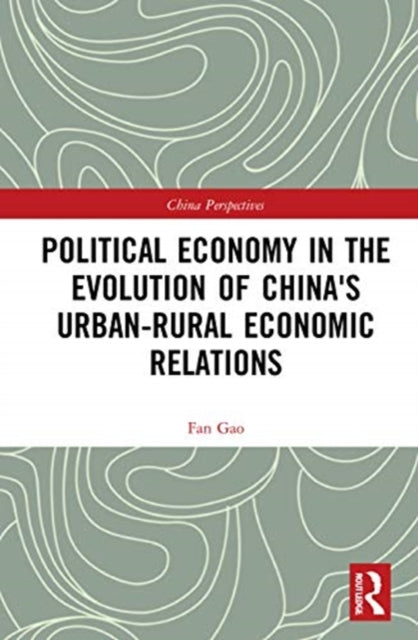Fan Gao
Political Economy in the Evolution of China's Urban-Rural Economic Relations
Political Economy in the Evolution of China's Urban-Rural Economic Relations
YOU SAVE £7.68
- Condition: Brand new
- UK Delivery times: Usually arrives within 2 - 3 working days
- UK Shipping: Fee starts at £2.39. Subject to product weight & dimension
Bulk ordering. Want 15 or more copies? Get a personalised quote and bigger discounts. Learn more about bulk orders.
Couldn't load pickup availability
- More about Political Economy in the Evolution of China's Urban-Rural Economic Relations
The integration of China's urban and rural economies has been uneven, with the city being the dominant partner. This has led to critical logic underlying the evolution of the relationship since 1949 and an alternative theoretical framework based on political economy.
Format: Hardback
Length: 298 pages
Publication date: 30 December 2021
Publisher: Taylor & Francis Ltd
Demonstrates the imbalanced integration as the main character of China's urban-rural economic relationship since reform and opening up.
Reveals the critical logic underlying the evolution of China's urban-rural economic relationship since 1949.
Puts forward an alternative theoretical framework based on political economy.
China's urban-rural economic relationship has undergone significant changes since the reform and opening up in the late 1970s. Prior to this period, China was characterized by a highly centralized economic system, with the majority of the population living in rural areas and relying on agriculture for their livelihood. However, with the introduction of market-oriented reforms, the country began to urbanize rapidly, leading to a growing divide between urban and rural areas.
One of the main features of China's urban-rural economic relationship is the imbalanced integration. While the urban areas have experienced rapid economic growth and development, the rural areas have faced numerous challenges, including poverty, unemployment, and limited access to basic services. This imbalance has led to a growing gap between the urban and rural populations, with many rural residents struggling to make ends meet while urban residents enjoy a higher standard of living.
The critical logic underlying the evolution of China's urban-rural economic relationship since 1949 can be traced back to the country's political system. Under the communist regime, the government controlled all aspects of the economy, including land and resources. This led to a concentration of wealth and power in the hands of a small elite, while the majority of the population lived in poverty.
As China began to open up to the world in the late 1970s, the government began to introduce market-oriented reforms to promote economic growth and development. However, these reforms were implemented in a way that favored the urban areas, leading to the concentration of wealth and resources in the hands of a small elite in the cities. This has resulted in the urban-rural economic imbalance that we see today.
To address this imbalance, it is important to develop an alternative theoretical framework based on political economy. This framework would recognize the importance of both urban and rural areas in the economy and would aim to promote their sustainable development. One potential approach is to promote rural-urban integration by investing in infrastructure and services in rural areas, such as education, healthcare, and transportation. This would help to reduce the gap between urban and rural areas and promote a more equitable distribution of resources.
Another approach is to promote urban-rural cooperation by encouraging the flow of labor and capital between urban and rural areas. This could be achieved through policies such as tax incentives for businesses that invest in rural areas, as well as programs that encourage rural residents to move to urban areas and find employment.
In conclusion, China's urban-rural economic relationship has undergone significant changes since the reform and opening up in the late 1970s. The imbalanced integration between urban and rural areas has led to a growing gap between the urban and rural populations, with many rural residents struggling to make ends meet. To address this imbalance, it is important to develop an alternative theoretical framework based on political economy that recognizes the importance of both urban and rural areas and promotes their sustainable development. By investing in infrastructure and services in rural areas and promoting urban-rural cooperation, we can create a more equitable and prosperous society for all.
Dimension: 234 x 156 (mm)
ISBN-13: 9781032028378
This item can be found in:
UK and International shipping information
UK and International shipping information
UK Delivery and returns information:
- Delivery within 2 - 3 days when ordering in the UK.
- Shipping fee for UK customers from £2.39. Fully tracked shipping service available.
- Returns policy: Return within 30 days of receipt for full refund.
International deliveries:
Shulph Ink now ships to Australia, Belgium, Canada, France, Germany, Ireland, Italy, India, Luxembourg Saudi Arabia, Singapore, Spain, Netherlands, New Zealand, United Arab Emirates, United States of America.
- Delivery times: within 5 - 10 days for international orders.
- Shipping fee: charges vary for overseas orders. Only tracked services are available for most international orders. Some countries have untracked shipping options.
- Customs charges: If ordering to addresses outside the United Kingdom, you may or may not incur additional customs and duties fees during local delivery.


